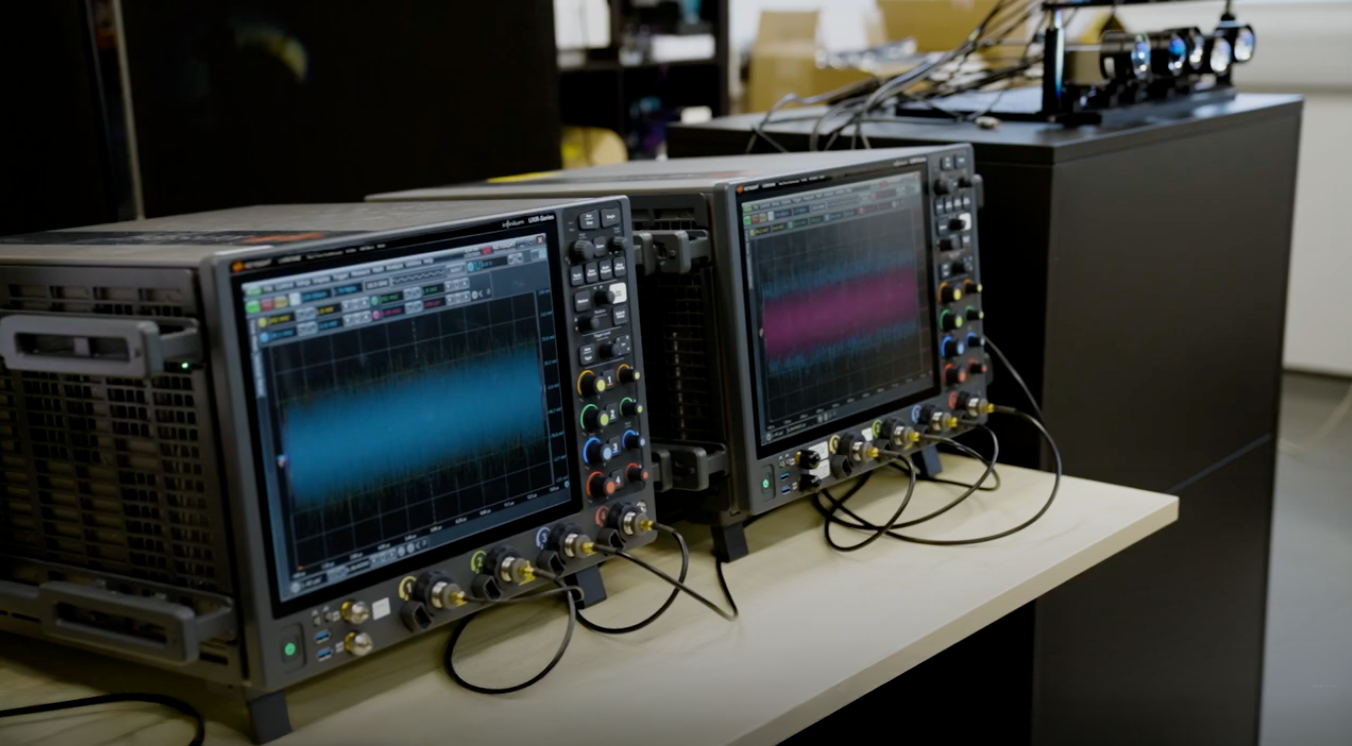HASC News
Spectrum is the invisible infrastructure of our connected world. Every time we send a message, stream a video, or connect a device, we are relying on carefully managed slices of spectrum – the defined radio and optical frequencies through which wireless digital information flows. But this space is becoming increasingly crowded as our demand for mobile data grows year on year. By 2030, Ofcom has estimated that UK mobile data demand may be 7.5 to 52 times the level of 2021, and as high as 19 to 540 times by 2035. Managing the spectrum has therefore become both a highly complex and increasingly urgent challenge.

What Is Spectrum Management?
Although the electromagnetic spectrum is theoretically continuous, only certain ranges are practical for communications. Very low frequencies cannot carry high data rates, while extremely high frequencies – such as X-rays or gamma rays – are unsafe or impractical. This means that the usable portion (from 300 kHz to 300 GHz) is a finite resource.
Spectrum management is the coordinated allocation and management of usable frequencies to ensure wireless communication services can operate efficiently and without interfering with each other. Regulators (such as Ofcom for the UK) assign specific frequency bands for designated purposes – such as mobile phone networks, public safety functions, and satellite services. Telecommunication providers bid for frequency band licenses, then build infrastructure to deliver services.
Why Spectrum Management Matters
Communications infrastructure is now as essential to our societies as electricity or water. In 2023, the UK Government described spectrum as a ‘critical national asset’, with ‘more efficient and intelligent use of spectrum’ a priority for continued growth across many sectors.
But just as demand for mobile data is rising exponentially, available spectrum in the most practical frequency range is becoming scarce. Usage is also becoming highly concentrated; for instance, most (around 80%) of wireless traffic now occurs indoors, carried over Wi-Fi or indoor mobile coverage. This places disproportionate pressure on lower frequency bands that propagate more easily through walls and other obstacles.
Meanwhile, emerging technologies, such as the future 6G, are pushing into higher frequency bands, including terahertz, which are technically more challenging and typically demand line-of-sight transmission. As more frequency bands come on board, this adds to the increasing complexity of the network, already convoluted by many legacy systems.
Energy consumption is also an increasing concern. If the UK is to achieve its Net Zero targets, reducing the energy footprint of data delivery is a key priority – however, improving energy-efficiency does not always align with achieving best spectral efficiency.
Meeting these challenges will require coordinated innovation that integrates technological advances with industry leadership and a supportive policy framework. HASC works at the intersection of these areas, forging towards a vision of seamless, energy-efficient spectrum management for tomorrow’s communication networks.
Addressing Congestion Through New Spectrum Access
Through our Connectivity work stream, led by University College London, HASC is investigating novel technologies that can use new regions of the spectrum, including terahertz and optical wireless domains. The optical spectrum is particularly attractive; unlike radio frequencies, much of the optical spectrum is not subject to regulatory licensing, and offers around 3,000 times more bandwidth. To tap into this opportunity, HASC researchers at Cambridge are pioneering Li-Fi: a high-speed wireless technology that uses light instead of radio waves. Experimental systems have achieved ultra-fast data transmission speeds of 100 Gbps; future work will build scalable systems that can support next-generation applications, and reduce pressure on the congested radio spectrum.

In the wired domain, a promising innovation is hollow-core fibres, where light travels through a hollow (air-filled) core instead of solid glass. These have the potential to transmit data with lower loss and latency, enabling higher speeds and energy efficiency in high-capacity settings such as data centres. Meanwhile HASC researchers at the University of Oxford are exploring how to link wired and wireless communication networks using light, by developing virtual fibres to provide high-speed wireless connectivity indoors. Data carried over fibres via light is then directed by a base station in the ceiling to travel wirelessly through free-space to a mobile terminal and back into a wired connection.
Improvements can also still be made in the radio frequency domain. Reassigning bandwidth in underutilised frequencies and decommissioning legacy networks, such as 2G, both offer ‘low-hanging fruit’ to free up capacity. A key focus for HASC, meanwhile, is exploring how we can ‘engineer’ the propagation environment using intelligent surfaces to overcome the natural travel limitations of higher-frequency signals, which could free up pressure on lower frequencies. This could include, for instance, engineered panels that guide radio signals more effectively through complex environments.
Managing Complexity with Adaptive and Multi-Band Systems
HASC’s Adaptivity programme, led by the University of Bristol, is addressing how we can efficiently manage the increasing heterogeneity of communications networks, with fibre, Wi-Fi, mobile, and optical systems operating in parallel. This work includes developing algorithms and AI-enabled control frameworks that can intelligently assess the most effective connectivity mode in real time, taking into account factors such as congestion, bandwidth availability, interference, and energy consumption.
A core element of this work is multi-band communication, where different portions of the spectrum (terahertz, radio frequency, and optical) are used simultaneously to enhance throughput and resilience. For instance, during emergencies or natural disasters, adaptive networks could quickly shift traffic from damaged wired infrastructure to wireless alternatives, maintaining critical communications when they are needed most.
This approach already shows promise in optical systems. Recent HASC research into multi-band optical transmission has demonstrated that by using extra spectrum beyond the traditional C-band (such as L- and S-bands) fibre networks could quadruple their capacity. Managing this expanded spectrum is technically challenging, but by applying deep reinforcement learning (a branch of AI that learns by trial and error) the research team reduced service blocking by up to 85% compared with conventional techniques, while keeping decision times practical.
Quantum and Spectrum Management
Communications systems are becoming increasingly complex and ensuring these remain secure is an ongoing challenge. Integrating new quantum technologies within the spectrum used by current systems, however, could provide enhanced security benefits. Through the Security challenge, led by the University of Cambridge, HASC researchers are investigating quantum key distribution (QKD) for both wired and wireless communication systems. QKDs use quantum mechanics to generate cryptographic keys that immediately alter their state in response to attempts to intercept or observe them. This makes them theoretically immune to eavesdropping, since this would alert the network to the presence of the breach.
Improved Energy Efficiency in Data Transport
Many of these technologies that HASC is exploring have the added potential benefit of reducing energy needs besides improving connectivity. Intelligent reflecting surfaces, for instance, reduce wasted transmitted power from poorly-propagating signals, whilst AI-enabled control frameworks could automatically select the most energy-efficient communication mode for a given situation. New types of optical fibre, meanwhile, could transmit much higher volumes of data, improving energy usage. In combination, these advances could enable future networks to deliver vastly more data without a proportional increase in energy use.
Looking to The Future
Ultimately, the goal of seamless, efficient spectrum management is inextricable from HASC’s vision of combining wired and wireless internet technologies into a single resource in order to deliver intelligent ‘all-spectrum’ end-to-end connectivity. Only then can we design future-proof networks that can intelligently adapt to meet the current and ever-evolving data demands of modern societies. By integrating advances across fibre, wireless, AI, and quantum, HASC is ensuring the UK remains at the forefront of research-led innovation to manage this unseen, yet essential asset.
Want to stay involved? Keep an eye on our channels for updates, opportunities, and news from across the HASC community.
